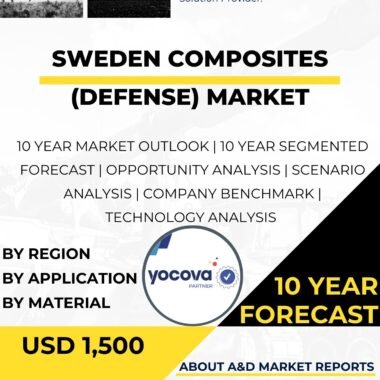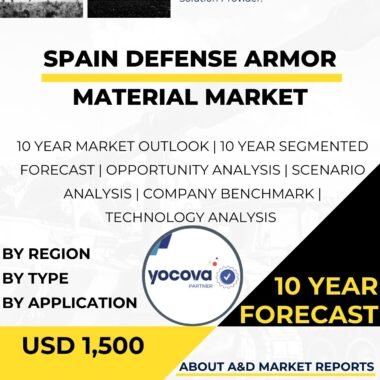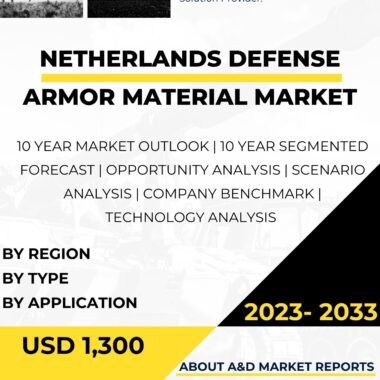Description
Brazil’s Defense Armor Material Market: Modernizing Protection
The Brazil Defense Armor Material market is a critical, evolving sector. It significantly enhances the country’s defense capabilities. Armor materials are essential components for various defense platforms. These platforms include military vehicles, aircraft, naval vessels, and soldiers’ personal protective equipment. These materials provide crucial protection. They guard against ballistic threats like bullets and shrapnel, as well as against blasts, impacts, and chemical hazards. Brazil seeks to modernize its armed forces and address new security challenges. Consequently, demand for advanced and lightweight armor materials is rising.
Land and Maritime Applications
Armor materials profoundly impact land-based defense applications. Brazil’s defense industry includes major companies like Avibras Indústria Aeroespacial and Taurus Armas. These companies manufacture diverse military vehicles and small arms. Armor materials, such as composite ceramics, steel, and advanced fibers like aramids, protect armored vehicles and personnel. They defend against enemy fire and explosive threats. By employing high-quality armor materials, Brazil improves its ground forces’ survivability and effectiveness. This allows them to operate in hostile environments and fulfill missions with greater confidence.
Furthermore, armor materials are essential for maritime defense applications, especially in naval vessels. The Brazilian Navy uses advanced armor materials to protect its warships and patrol boats. This protection guards against threats such as anti-ship missiles and small arms fire during boarding operations. Integrating ballistic protection into vessel design ensures the safety of onboard personnel and the maritime fleet’s operational readiness.
Market Dynamics and Domestic Growth
The Brazil Defense Armor Material market features both domestic and international players. They offer a diverse range of solutions to meet the specific needs of different defense platforms. Local companies, such as Engesolda – Engenharia em Solda Ltda, actively develop and produce indigenous armor materials. This contributes to Brazil’s defense industrial capabilities. Simultaneously, collaborations with global armor material manufacturers facilitate technology transfer. These partnerships help the country adopt cutting-edge solutions for its defense equipment.
To stimulate growth, the government proactively supports research and development initiatives. It provides funding for projects that enhance domestic armor material production capabilities. Investments in human resources and technology transfer agreements also nurture domestic expertise in protective materials.
Expanded Roles and Critical Infrastructure
The market extends beyond traditional defense applications. Brazil’s law enforcement agencies, including the Brazilian Federal Police and Military Police, also use armor materials. These materials protect officers during high-risk operations and against criminal activities. Advanced ballistic vests and helmets made with cutting-edge materials contribute to law enforcement personnel safety and protection.
In addition, armor materials protect critical infrastructure and assets. Brazil’s infrastructure (e.g., power plants, government buildings, and transportation hubs) faces vulnerability to terrorist attacks or sabotage. Integrating armor materials into critical infrastructure design enhances its resilience. This ensures essential services continue operating even during security incidents.
Challenges and Outlook
Brazil seeks to improve its defense industry’s technological capabilities. Therefore, research and development efforts are crucial for advancing indigenous armor materials. Collaborations between the government, defense agencies, research institutions, and private companies foster innovation. This knowledge exchange drives progress in protective materials. This commitment to domestic R&D builds Brazil’s strategic autonomy and self-reliance in armor material production.
However, the market faces certain challenges. One key challenge is the continuous evolution of ballistic threats. This demands constant innovation and improvements in armor material design and production. To stay ahead, Brazilian companies must invest in R&D. They need to create state-of-the-art armor materials that offer maximum protection without compromising weight and mobility.
Moreover, ensuring the quality and performance of armor materials is paramount. Rigorous testing and certification must meet international ballistic standards and safety regulations. Brazil’s domestic manufacturers must maintain high-quality standards to guarantee the effectiveness of protective materials in critical defense applications.
Conclusion
The Brazil Defense Armor Material market is a pivotal sector. It drives the country’s defense modernization and security efforts. Armor materials provide vital protection to military personnel, vehicles, and critical infrastructure. Through strategic partnerships, R&D investments, and collaborations, Brazil can enhance its indigenous capabilities. Addressing challenges like technological advancements, quality assurance, and emerging threats will unlock the market’s full potential and ensure the country’s security.




